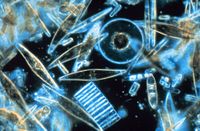
Photo from wikipedia
Silicification was a major mode of fossilization in Proterozoic peritidal environments, but marine silica concentrations and the chemical and biological mechanisms that drove microbial silicification and formation of early diagenetic… Click to show full abstract
Silicification was a major mode of fossilization in Proterozoic peritidal environments, but marine silica concentrations and the chemical and biological mechanisms that drove microbial silicification and formation of early diagenetic chert in these environments remain poorly constrained. Here, we use taphonomy experiments to demonstrate that photosynthetically active cyanobacteria that are morphologically analogous to the oldest cyanobacterial fossil, Eoentophysalis, mediate the formation of magnesium-rich amorphous silica in seawater that is undersaturated with respect to silica. These results show that microbes in Proterozoic tidal environments may have mediated their own silicification at lower silica concentrations than previously assumed.
Journal Title: Geology
Year Published: 2020
Link to full text (if available)
Share on Social Media: Sign Up to like & get
recommendations!